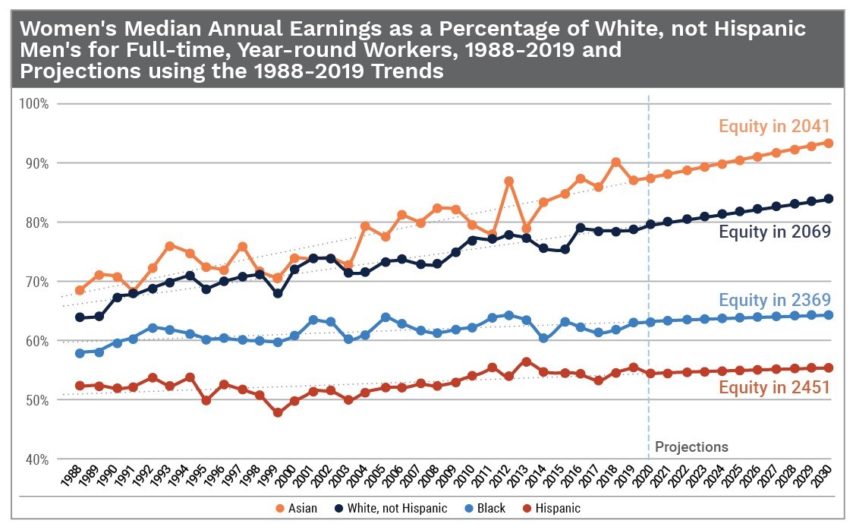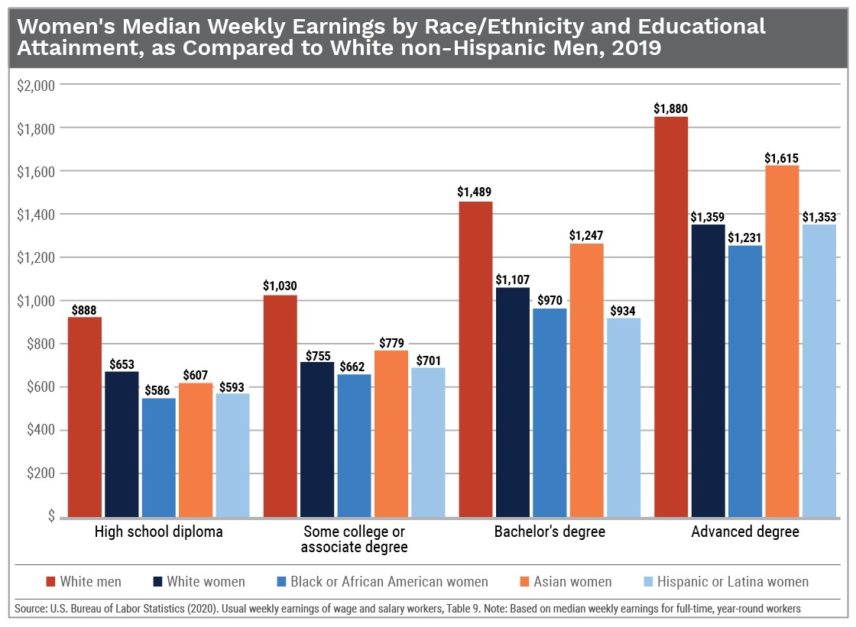America’s history of slavery, segregation and exploitation of immigrants has created deep-rooted inequalities that persist today. Consequently, most women of color have not had – nor do they have now — access to the same education and employment opportunities that white people have. For instance, Black women and Latinas are disproportionately working in service, domestic, caregiving and agricultural jobs, which have been systemically undervalued and undercompensated.
Race and the Pay Gap
The wage gap for many women of color is not only wider than the overall gender wage gap, but it is also closing more slowly.
While the gaps for white and Asian women compared to white, non-Hispanic men remain significant, they have narrowed much more over the past 30 years than the gaps for Black women and Latinas.
Since 1988:
- The Asian women’s earnings ratio changed from 69% to 87% – an 18% difference. The gap is projected to close in 22 years (in 2041).
- The white women’s earnings ratio changed from 64% to 79% – a 15% difference. The gap is projected to close in 50 years (in 2069).
- The Black women’s earnings ratio changed from 59% to only 63% – a 4% difference. At this rate, the gap will not close for 350 years (in 2369).
- The Latina earnings ratio changed from 53% to 55% – only a 2% difference. At this rate, the gap will not close for 432 years (in 2451).

Even as women of color earn bachelor’s and graduate degrees, their wage gaps compared to white, non-Hispanic men have remained the same or increased.
- Black women who graduated high school earned 65.99% of what similarly educated white, non-Hispanic men earned. When they completed a bachelor’s degree, that earnings ratio dropped to 65.14%.
- Latina women who graduated high school earned 66.78% of what white, non-Hispanic male high school graduates earned—a number that dropped to 62.73% upon graduating with their bachelor’s degree.
- Native American women who earned a high school diploma earned 66.7% of what their white, non-Hispanic male counterparts earned. That number fell to 59.2% for Native American women with a bachelor’s degree.
- White women do not face these same issues: their wage gap compared to white, non-Hispanic men decreases with increased education.
 Asian women appear to fare better in terms of the wage gap than any other group of women, but numbers can be deceiving. Asian women’s experiences differ greatly depending on their country of origin. An analysis by the National Partnership for Women and Families found that while women who report Indian or Chinese ethnicity or ancestry earn nearly as much as white men, women who identify as Filipina, Vietnamese, and Korean are paid much less.[i] And all are subjected to the model minority myth, which erases ethnic subgroups’ diverse experiences as well as racism against Asian Americans as a whole.
Asian women appear to fare better in terms of the wage gap than any other group of women, but numbers can be deceiving. Asian women’s experiences differ greatly depending on their country of origin. An analysis by the National Partnership for Women and Families found that while women who report Indian or Chinese ethnicity or ancestry earn nearly as much as white men, women who identify as Filipina, Vietnamese, and Korean are paid much less.[i] And all are subjected to the model minority myth, which erases ethnic subgroups’ diverse experiences as well as racism against Asian Americans as a whole.
Black Women & the Pay Gap
Workplace and Economic Equity

The Simple Truth About the Gender Pay Gap
Research & Data

Fast Facts: Occupational Segregation
Workplace and Economic Equity

